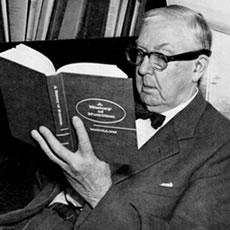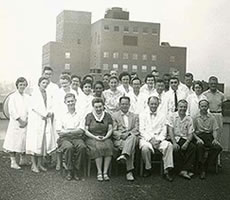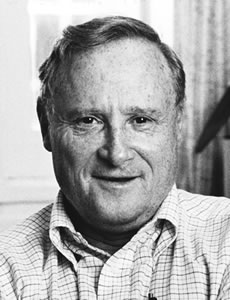History
The Department of Biochemistry and Molecular Biology (BMB) is proud to trace its roots back to 1917 as one of the founding departments in the Bloomberg School.

Then known as the Department of Chemical Hygiene, its first professor and chair, E.V. McCollum, discovered vitamin A, co-discovered vitamin D, and established the importance of trace metals in the diet—findings that led, in part, to fluoridation of drinking water. He is recognized as being the first researcher to use rats as an animal model for investigation of human dietary needs. McCollum communicated his findings to the public through newspaper and magazine articles and he used this pulpit to champion legislation that milk be supplemented with vitamin D and flour with the soluble B vitamins. This tradition of applying basic scientific investigation to important public health problems continues today, guiding our research and teaching philosophy as we train students to become innovative scientists and professionals.

McCollum renamed the department Biochemistry in 1932, as biochemists began to study protein and nucleic acid macromolecules as functional agents, not simply serving as passive structural elements of cells. Following McCollum’s retirement, Roger M. Herriott became Chair in 1948. Herriott transferred from the prestigious Rockefeller Institute, where he was a colleague of Oswald Avery, who identified DNA in 1944 as being the carrier of genetic information. Herriott had studied the effects of x-rays on bacterial viruses at Rockefeller, and his arrival in Baltimore spawned the first investigations of nucleic acids at Johns Hopkins. His research in the Biochemistry Department focused on basic virology, photoreactivation repair of DNA damaged with ultraviolet light, mutagenesis, and genetic transformation of cells by exogenous DNA. Herriot is widely credited with framing the concept that bacteriophages inject their genetic material in a hypodermic needle-like fashion into their bacterial hosts. During this three-decade long period, the Department expanded into genetics and molecular biology, but also maintained its grounding in nutrition, recruiting notable scientists, such as Bacon Chow, who studied the effects of maternal diet on progeny. In 1973, the free-standing Division of Biophysics was assimilated into the Department. This merger added research areas such as nucleotide analogs, cellular differentiation, and RNA antisense therapeutics to the growing repertoire of departmental research interests.

In 1975, Lawrence Grossman, a pioneer in the field of DNA-repair biochemistry, was named department chair. The subsequent period encompassed a shift toward research at the molecular level, with a particular focus on molecular carcinogenesis. Grossman was renowned for his colorful personal history as well as his scientific expertise: he quit high school to serve as a Navy fighter pilot in World War II. A much-decorated flying ace, Grossman never failed to acknowledge the GI Bill that provided for his postwar college education. His research at Johns Hopkins was instrumental in identifying the mechanisms responsible for excision of pyrimidine dimers from UV-irradiated DNA. Later, Grossman developed sensitive laboratory tests that illuminated how human DNA-damage repair capacity varied between individuals and measured how it declined with age. Grossman led faculty recruitment efforts that expanded the Department’s research interests to include nucleic acid enzymology, molecular nutrition, cancer virology, and the mechanisms of glycolipid and glycoprotein synthesis.
Following Grossman’s retirement, Roger McMacken was selected as Department Chair in 1990. A leader in the field of DNA replication, McMacken identified the replicative helicase that drives propagation of replication forks in all bacteria and developed reconstituted protein systems that specifically assemble complex replicase machines at chromosomal replication origins. He diversified the department’s interests further to topics such as protein biochemistry in mammalian systems and cellular regulatory mechanisms in eukaryotes. The latter topics included pivotal studies of post-translational protein conjugation to small proteins, such as ubiquitin or SUMO, and investigations of gene silencing mechanisms by epigenetic modification of DNA and histones.
In 1998, the Division of Reproductive Biology officially joined BMB. Established in the School in 1972, the Division emphasizes research in cell biology, physiology and the genetics of reproductive processes. The Division brought to BMB a unique master’s program that was modified and expanded to become the master’s Program in Reproductive and Cancer Biology. BMB currently has two master’s programs, the one-year Master of Health Science focused on the intersection of basic science and medicine and a two-year Master of Science program that builds on the MHS coursework with an independent research project in a faculty mentor’s laboratory. The Department also spearheaded the first fully-online master’s program in the Bloomberg School of Public Health, an interdepartmental Master of Arts in Public Health Biology, launched in 2017.
Pierre A. Coulombe became the Department permanent Chair in 2008 as BMB entered a new period of expansion. Coulombe, who has made several seminal discoveries about the properties and roles of keratin intermediate filaments and their role in skin diseases, was elected fellow of the American Association for the Advancement of Science in 2009, continuing the tradition of excellence in science and leadership begun nearly 100 years earlier by E.V. McCollum. Coulombe’ faculty recruitments further expanded and deepened the expertise of the department in areas including structural biology, molecular nutrition, stem cells, neurodegenerative and other chronic diseases, and epigenetics.
Following Coulombe’s departure in 2017, Professor Michael Matunis served as Interim Chair until 2019. Highlights of his time leading the department include his work on the 2018 BMB Reunion celebrating former chair Roger McMacken and setting up the Brian D. Crawford and Family Research Scholarship and the Roger McMacken Scholarship Fund.
The current Chair, Ashani Weeraratna, joined the Department in 2019 and is a Bloomberg Distinguished Professor in Cancer Biology, as well as the co-Program Leader of the Sidney Kimmel Comprehensive Cancer Center’s Cancer Invasion and Metastasis program. She is both the first woman and the first person of color to chair the department. She is an expert in melanoma biology, serving as the President of the Society for Melanoma Research. She has made fundamental discoveries describing the impact of the aging microenvironment on metastasis and therapy resistance. She brings to the department a strong spirit of collaboration building bridges across departments in the School of Public Health, as well as strong links to the Sidney Kimmel Cancer Center and other departments across the University. She has placed a specific emphasis on the value of diversity, and her recent faculty recruitments strengthen not only the diversity of the department, but increase its expertise in bioinformatics, cancer, and transcriptional biology.
Today, BMB comprises roughly 25 teaching and research faculty, 100 master’s students, 40 predoctoral students, and 20 postdoctoral fellows and visiting students. BMB’s research interests have evolved over the past quarter century to include cellular stress responses, genome integrity, protein homeostasis, structural biology, biomolecular condensates, cancer, and aging.
In recent years, BMB held events to celebrate our history and highlight our ongoing work. Learn more at our pages for the Department Centennial Celebrations and the 2018 BMB Reunion.
